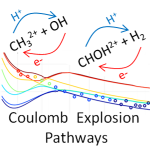Citation:
| luzon2019making.pdf | 1.24 MB |

Abstract:
A multifaceted agreement between ab initio theoretical predictions and experimental measurements, including branching ratios, channel-specific kinetic energy release, and three-body momentum correlation spectra, leads to the identification of new mechanisms in Coulomb-explosion (CE) induced two- and three-body breakup processes in methanol. These identified mechanisms include direct nonadiabatic Coulomb explosion responsible for CO bond-breaking, a long-range “ inverse harpooning” dominating the production of H2+ + HCOH+, a transient proton migration leading to surprising energy partitioning in three-body fragmentation and other complex dynamics forming products such as H2O+ and H3+. These mechanisms provide general concepts that should be useful for analyzing future time-resolved Coulomb explosion imaging of methanol as well as other molecular systems. These advances are enabled by a combination of recently developed experimental and computational techniques, using weak ultrafast EUV pulses to initiate the CE and a high-level quantum chemistry approach to follow the resulting field-free nonadiabatic molecular dynamics.



